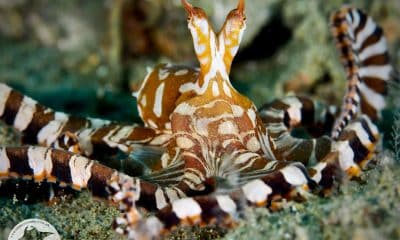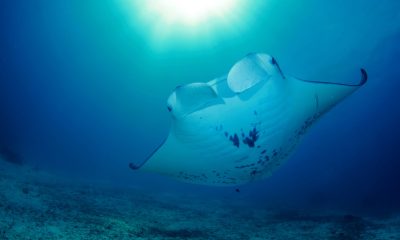News
Komodo: the underwater laboratory
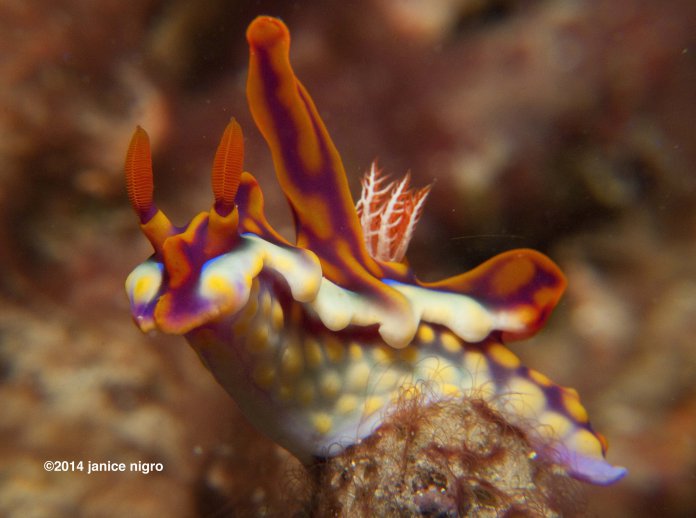
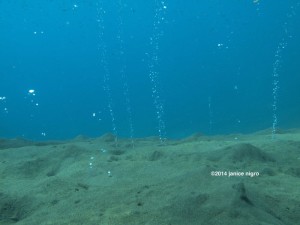 Volcanic gas bubbles were percolating from the sandy bottom below me. Yellow particles of sulfur that had precipitated out of these gases from Sangeang Volcano, dusted the perfectly black sand, and the sand was warm to the touch. I thought, it is a good thing that I have my underwater “safety goggles” on, as it was my first sense that in the sea in Komodo a delicate (or perhaps explosive) experiment was still in progress. There in front of me I felt like I had an eyewitness view below the surface of the ocean to the basic ingredients necessary to cook-up life.
Volcanic gas bubbles were percolating from the sandy bottom below me. Yellow particles of sulfur that had precipitated out of these gases from Sangeang Volcano, dusted the perfectly black sand, and the sand was warm to the touch. I thought, it is a good thing that I have my underwater “safety goggles” on, as it was my first sense that in the sea in Komodo a delicate (or perhaps explosive) experiment was still in progress. There in front of me I felt like I had an eyewitness view below the surface of the ocean to the basic ingredients necessary to cook-up life.
Komodo lies in Indonesia within the Coral Triangle, where the richest biodiversity in marine life resides. However, Komodo probably made an unforgettable first impression on me, like most kids growing up in the Midwest, through the images of a land animal, the Komodo dragon. I could not have imagined then, mesmerized in front of the TV, that it would be through scuba diving that I would get there.
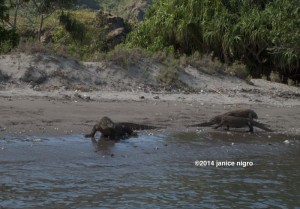 As a dive destination, Komodo is known for its swift currents and cool thermoclines. Based on these characteristics, I was somewhat reluctant to dive Komodo. Furthermore, reading about diver mishaps in Komodo, which is easy to do because of the Internet, did not settle the issue. A culmination of a diver’s worst nightmare in Komodo was actually a true story: divers had been both swept away and had to fight off Komodo dragons after finding refuge on an island. I am not in for that much adventure (or effort), but what I discovered, is that divers in Komodo who are most vulnerable to these incidents are the ones from liveaboards without dedicated boat tenders. I decided then that for my Komodo experience, I would take the Seven Seas, a big boat, with an attentive crew, that is well known for establishing underwater exploration of the area as a dive destination.
As a dive destination, Komodo is known for its swift currents and cool thermoclines. Based on these characteristics, I was somewhat reluctant to dive Komodo. Furthermore, reading about diver mishaps in Komodo, which is easy to do because of the Internet, did not settle the issue. A culmination of a diver’s worst nightmare in Komodo was actually a true story: divers had been both swept away and had to fight off Komodo dragons after finding refuge on an island. I am not in for that much adventure (or effort), but what I discovered, is that divers in Komodo who are most vulnerable to these incidents are the ones from liveaboards without dedicated boat tenders. I decided then that for my Komodo experience, I would take the Seven Seas, a big boat, with an attentive crew, that is well known for establishing underwater exploration of the area as a dive destination.
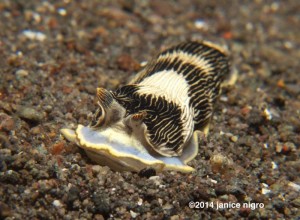 Komodo, like most of Indonesia, is a string of islands created by volcanic eruptions. To dive Sangeang early in the itinerary was a prelude to the park not only because it is a volcano, but because it also seems to set time back to the beginning. It is particularly fascinating to me as a diver, as there is a combination of geological, geographical as well as biological phenomena to experience. Smoke plumes surround the peak of Sangeang, but that it is active, is more easily viewed on the sea floor at dive sites like the one described above, Tiny Bubbles. It is an ethereal place, dark because of the black rock, but clearly rich with nutrients for the plethora of vibrantly colored soft corals growing like wall hangings from the blocks of volcanic basalt. It has the feeling of an underwater burn area where soft and whip corals flourish as do wild flowers after the spring rains following a fire. Nudibranchs are prolific here, as is macro life in general. The dive guides found a big-bellied red Bargi Banti pygmy sea horse, a tomezuma shrimp, and a xenocrab.
Komodo, like most of Indonesia, is a string of islands created by volcanic eruptions. To dive Sangeang early in the itinerary was a prelude to the park not only because it is a volcano, but because it also seems to set time back to the beginning. It is particularly fascinating to me as a diver, as there is a combination of geological, geographical as well as biological phenomena to experience. Smoke plumes surround the peak of Sangeang, but that it is active, is more easily viewed on the sea floor at dive sites like the one described above, Tiny Bubbles. It is an ethereal place, dark because of the black rock, but clearly rich with nutrients for the plethora of vibrantly colored soft corals growing like wall hangings from the blocks of volcanic basalt. It has the feeling of an underwater burn area where soft and whip corals flourish as do wild flowers after the spring rains following a fire. Nudibranchs are prolific here, as is macro life in general. The dive guides found a big-bellied red Bargi Banti pygmy sea horse, a tomezuma shrimp, and a xenocrab.
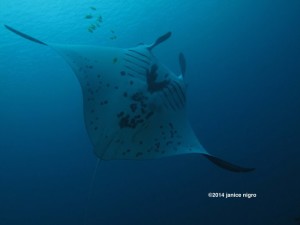 We shifted our eyes from macro to wide angle when we arrived at Manta Alley. Our backward roll was into an amphitheater formed of volcanic rock, and we descended to the sandy bottom at 25 meters where we remained stationary to watch the mantas overhead. The volcanic amphitheater provides a spectacular backdrop for viewing the manta rays, and at times, I forgot that I was there to watch the mantas and not the many sessile creatures that live in these walls as permanent spectators to the graceful pelagic animals. We viewed at least eight different manta rays, and on the second dive, the animals were even friendlier, swimming so close as if wanting to make contact. Afterwards when I asked about how to differentiate between male and female rays (I can’t leave the scientist at home), I learned, instead, that we actually saw the two types of manta rays, oceanic and reef, and that they are distinguishable largely based on patterns of coloration.
We shifted our eyes from macro to wide angle when we arrived at Manta Alley. Our backward roll was into an amphitheater formed of volcanic rock, and we descended to the sandy bottom at 25 meters where we remained stationary to watch the mantas overhead. The volcanic amphitheater provides a spectacular backdrop for viewing the manta rays, and at times, I forgot that I was there to watch the mantas and not the many sessile creatures that live in these walls as permanent spectators to the graceful pelagic animals. We viewed at least eight different manta rays, and on the second dive, the animals were even friendlier, swimming so close as if wanting to make contact. Afterwards when I asked about how to differentiate between male and female rays (I can’t leave the scientist at home), I learned, instead, that we actually saw the two types of manta rays, oceanic and reef, and that they are distinguishable largely based on patterns of coloration.
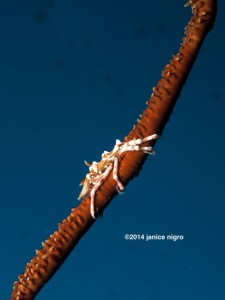 Horseshoe Bay is the dive destination within the heart of Komodo. It harbors a spectacular series of dives within a small area, and at the same time offers the first opportunity to view the infamous Komodo dragon in one of its natural habitats, the beach on Rinca Island. Here, crab eating macaques skip around on the rocky section of the beach collecting the shellfish when the tide is out, while the dragons slink out in public only when the sun is at its peak and the sand at its warmest. The dragons are surprisingly inactive and look more like statues sculpted from the very sand upon which they rest. They only appear to be alive because of their nonstop drool that seems thick enough to tether them to the beach. Fortunately, they do not like to swim so much.
Horseshoe Bay is the dive destination within the heart of Komodo. It harbors a spectacular series of dives within a small area, and at the same time offers the first opportunity to view the infamous Komodo dragon in one of its natural habitats, the beach on Rinca Island. Here, crab eating macaques skip around on the rocky section of the beach collecting the shellfish when the tide is out, while the dragons slink out in public only when the sun is at its peak and the sand at its warmest. The dragons are surprisingly inactive and look more like statues sculpted from the very sand upon which they rest. They only appear to be alive because of their nonstop drool that seems thick enough to tether them to the beach. Fortunately, they do not like to swim so much.
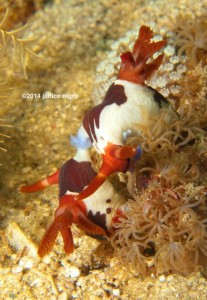 The dives in this area often had a bit of current at the surface, so negative entries were necessary. However, once under the surface, the current was not detectable. Cannibal Rock, named after a behavior of the dragons and not the humans, is a fabulous volcanic peak that you circle but never in a single dive, as it is crowded with soft corals, anemones, mating nudibranchs, frogfish, and shrimp. It is possibly the worse case of ADHD my eyes and I could ever have, because I could not prioritize where to stop and to look. Thankfully, I had the Incredibles, a.k.a. the dive guides from North Sulawesi, to help me sort it out and to identify specific, unique creatures. The Yellow Wall o’ Texas is one of the most extraordinary wall dives on the trip, in that the soft corals are swollen open all day long due to currents even in the bright sunlight. It is a hypnotic ride along a wall of soft corals and anemones rhythmically responding to the current, but macro creatures can be found if there is a break in the flow. I spotted an enormous tambja affinis nudibranch (not exactly macro) and two zebra crabs on a fire urchin glued to the wall.
The dives in this area often had a bit of current at the surface, so negative entries were necessary. However, once under the surface, the current was not detectable. Cannibal Rock, named after a behavior of the dragons and not the humans, is a fabulous volcanic peak that you circle but never in a single dive, as it is crowded with soft corals, anemones, mating nudibranchs, frogfish, and shrimp. It is possibly the worse case of ADHD my eyes and I could ever have, because I could not prioritize where to stop and to look. Thankfully, I had the Incredibles, a.k.a. the dive guides from North Sulawesi, to help me sort it out and to identify specific, unique creatures. The Yellow Wall o’ Texas is one of the most extraordinary wall dives on the trip, in that the soft corals are swollen open all day long due to currents even in the bright sunlight. It is a hypnotic ride along a wall of soft corals and anemones rhythmically responding to the current, but macro creatures can be found if there is a break in the flow. I spotted an enormous tambja affinis nudibranch (not exactly macro) and two zebra crabs on a fire urchin glued to the wall.
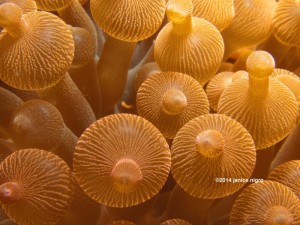 Eventually a dive comes along where I had to pay for all of the delicious desserts eaten on a 12-day liveaboard. The Three Sisters was finally that dive. The Three Sisters is a dive site of three underwater pinnacles that become progressively higher and are separated by several meters. The current was flowing into one side of the pinnacles so that the burn came at the entry just downstream of the current and in between them where the current ran through. On the entry, I refused to let my male dive guide get away from me so I kicked and kicked until I reached the other side of the ridge, stopped to breathe for a few minutes, and then proceeded.
Eventually a dive comes along where I had to pay for all of the delicious desserts eaten on a 12-day liveaboard. The Three Sisters was finally that dive. The Three Sisters is a dive site of three underwater pinnacles that become progressively higher and are separated by several meters. The current was flowing into one side of the pinnacles so that the burn came at the entry just downstream of the current and in between them where the current ran through. On the entry, I refused to let my male dive guide get away from me so I kicked and kicked until I reached the other side of the ridge, stopped to breathe for a few minutes, and then proceeded.
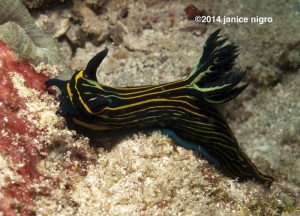 We were searching for the so-called chocolate crunchy peanut sea star (scientific name unknown), a species of starfish reportedly identified by the Seven Seas at this site, but instead found a giant yellow frogfish on the third sister and three orangutan crabs crowded on a single bubble coral on the sea floor. The highlight was a sort of underwater interracial couple, a trumpetfish closely lingering over a pufferfish. This behavior trick of the trumpetfish was not new to me. The trumpetfish hovers over the pufferfish just out of sight and is able to snatch unsuspecting fish that are normally at ease in the presence of the pufferfish. The pair really appeared to be more attentive to each other, like a romantic couple, rather than a devious trumpetfish camouflaged by a puffer. Rita, one of the other guests, even predicted the possible variations of their offspring if their real purpose was to mate. A spiny trumpetfish? A long snouted, yellow puffer?
We were searching for the so-called chocolate crunchy peanut sea star (scientific name unknown), a species of starfish reportedly identified by the Seven Seas at this site, but instead found a giant yellow frogfish on the third sister and three orangutan crabs crowded on a single bubble coral on the sea floor. The highlight was a sort of underwater interracial couple, a trumpetfish closely lingering over a pufferfish. This behavior trick of the trumpetfish was not new to me. The trumpetfish hovers over the pufferfish just out of sight and is able to snatch unsuspecting fish that are normally at ease in the presence of the pufferfish. The pair really appeared to be more attentive to each other, like a romantic couple, rather than a devious trumpetfish camouflaged by a puffer. Rita, one of the other guests, even predicted the possible variations of their offspring if their real purpose was to mate. A spiny trumpetfish? A long snouted, yellow puffer?
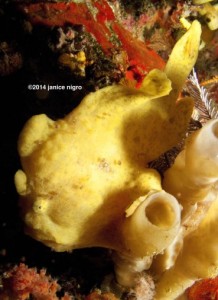 There were “sand-based” breaks from the boat. A very serious beach volleyball match took place between the crew, guests, and locals from an island that I can only report is somewhere. It was an unpredicted event in life. An easy hike to Pink Beach on another island to watch the sunset emphasized the remarkable diversity of the landscape of Komodo. The pink sand on this beach is created by the fragmentation of red coral.
There were “sand-based” breaks from the boat. A very serious beach volleyball match took place between the crew, guests, and locals from an island that I can only report is somewhere. It was an unpredicted event in life. An easy hike to Pink Beach on another island to watch the sunset emphasized the remarkable diversity of the landscape of Komodo. The pink sand on this beach is created by the fragmentation of red coral.
Beauty is flaunting itself everywhere in Komodo, but it lies deep within the muck dives if you are open to the challenge of finding it. I have noticed all too often divers surfacing before their 60 minutes are up in exasperation because muck dive sites are not “pretty”. To me, there is something compelling about these dives even though they at first may appear to be desolate. The dive guides always find something, so I take on these dives as a personal challenge to hunt as they do and persevere until the end of the 60 minutes as if I might find something awesome too! An easy afternoon muck dive at Wainilu proved exactly this point. For about the first 30 minutes of this dive, I felt as if I was immersed in a black and white photo, as there was low visibility and little sunlight. And then finally, a radiant spot of color, a yellow-ridged ceratosoma, appeared on the coral rubble. More nudibranchs came after that, including a huge, lumbering solar powered phyllodesmium longicirrum. Finally, our dive guide, digging through the coral rubble, uncovered a spiny tiger shrimp, one that I could actually see without a magnifying glass.
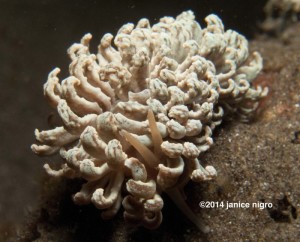 That feeling that a dinosaur would appear at any moment followed me throughout the trip, but it was especially on the night dives that I felt totally immersed in the primordial soup that is Komodo. Coral Garden is a name that sounds innocuous enough, but it was here that tiny bioluminescent beings hurled themselves at us at night. No one had a name for these creatures pulsating orange light, but I was clearly not the only one seeing them. At Torpedo Point in Horseshow Bay, I finally made a find that even the dive guide envied. Just as I reached the bottom, my flashlight beam caught a juvenile ornate ghost pipefish bouncing vertically over the sand as if its nose were too heavy. Our Incredible for the night dive quickly evened the score by finding the parent to the juvenile and then essentially outscored us by making torpedo rays appear out of the sand, revealing hidden shrimp in basket sea stars, and coercing delicate crabs out of their soft coral hideouts. Evolution seems to have a complete lack of any rational purpose when you evaluate the diversity of the creatures on these night dives.
That feeling that a dinosaur would appear at any moment followed me throughout the trip, but it was especially on the night dives that I felt totally immersed in the primordial soup that is Komodo. Coral Garden is a name that sounds innocuous enough, but it was here that tiny bioluminescent beings hurled themselves at us at night. No one had a name for these creatures pulsating orange light, but I was clearly not the only one seeing them. At Torpedo Point in Horseshow Bay, I finally made a find that even the dive guide envied. Just as I reached the bottom, my flashlight beam caught a juvenile ornate ghost pipefish bouncing vertically over the sand as if its nose were too heavy. Our Incredible for the night dive quickly evened the score by finding the parent to the juvenile and then essentially outscored us by making torpedo rays appear out of the sand, revealing hidden shrimp in basket sea stars, and coercing delicate crabs out of their soft coral hideouts. Evolution seems to have a complete lack of any rational purpose when you evaluate the diversity of the creatures on these night dives.
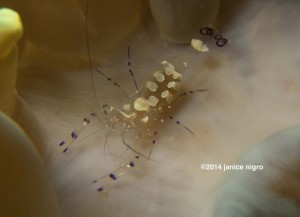 And at the end of a night dive, you surface under an unadulterated spectacle of the stars. In a place like Komodo, where there is no interference from man-made light, I could use even a weak flashlight, point to a star, and feel as if the beam of light reaches all the way into outer space and actually touches it. It occurred to me then that the magical life of Komodo might be created by some sort of a chemical reaction requiring the components of seawater and volcanoes and is ignited by sun-, star-, and moonlight.
And at the end of a night dive, you surface under an unadulterated spectacle of the stars. In a place like Komodo, where there is no interference from man-made light, I could use even a weak flashlight, point to a star, and feel as if the beam of light reaches all the way into outer space and actually touches it. It occurred to me then that the magical life of Komodo might be created by some sort of a chemical reaction requiring the components of seawater and volcanoes and is ignited by sun-, star-, and moonlight.
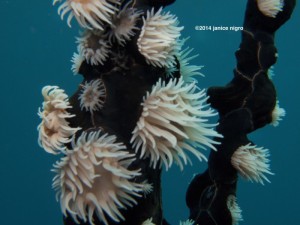 We were once again anchored in the harbor of Labuan Bajo, and Komodo and Rinca, Sangeang and Sumbawa were all new “is this even on Google maps” destinations that I had traveled to. Only the domestic flight remained. We had news that there had been an incident two days before where a cow wandered inadvertently in front of a jet that had just landed at the airport (the unpredictable). While no one was hurt, the plane was damaged, and this meant a delay as the airlines was catching up for the lack of flights on the two previous days. Considering these circumstances, I was, of course, anxious about the flight, but as we finally safely left the ground, I was more anxious about leaving Komodo and not ever returning.
We were once again anchored in the harbor of Labuan Bajo, and Komodo and Rinca, Sangeang and Sumbawa were all new “is this even on Google maps” destinations that I had traveled to. Only the domestic flight remained. We had news that there had been an incident two days before where a cow wandered inadvertently in front of a jet that had just landed at the airport (the unpredictable). While no one was hurt, the plane was damaged, and this meant a delay as the airlines was catching up for the lack of flights on the two previous days. Considering these circumstances, I was, of course, anxious about the flight, but as we finally safely left the ground, I was more anxious about leaving Komodo and not ever returning.
Blogs
The Ocean Cleanup Breaks 10,000,000 KG Barrier

The Ocean Cleanup, the global non-profit project, has removed a verified all-time total of ten million kilograms (22 million lbs.) of trash from oceans and rivers around the world – approximately the same weight as the Eiffel Tower.
To complete its mission of ridding the oceans of plastic, The Ocean Cleanup uses a dual strategy: cleaning up the Great Pacific Garbage Patch (GPGP) to remove the plastic already afloat in the oceans, while stopping the flow of plastic from the world’s most polluting rivers.
Through cleaning operations in the GPGP and in rivers in eight countries, the cumulative total of trash removed has now surpassed ten million kilograms. This milestone demonstrates the acceleration of The Ocean Cleanup’s impact, while underlining the astonishing scale of the plastic pollution problem and the need for continued support and action.
While encouraging for the mission, this milestone is only a staging point: millions more tons of plastic still pollute our oceans and The Ocean Cleanup intends to continue learning, improving and innovating to solve this global catastrophe.
This announcement comes as governments from around the world meet to continue negotiations to develop a new legally binding instrument to end plastic pollution at INC4 in Ottawa, Canada. Representatives of The Ocean Cleanup will be in attendance and the organization will be urging decision-makers to collaborate towards a comprehensive and ambitious global treaty which addresses plastic at all stages of its life cycle and in all marine environments worldwide, including in areas beyond national jurisdiction.
It is encouraging to see that the need for remediation is reflected in the various options for potential treaty provisions. It is essential that the final treaty contains clear targets for the remediation of legacy plastic pollution, and reduction of riverine plastic emissions.
Tackling plastic pollution requires innovative and impactful solutions. The treaty should therefore incentivize the innovation ecosystem by fostering innovations that make maximal use of data, technology and scientific knowledge – such as those designed and deployed by The Ocean Cleanup.
‘After many tough years of trial and error, it’s amazing to see our work is starting to pay off – and I am proud of the team who has brought us to this point.’ said Boyan Slat, Founder and CEO of The Ocean Cleanup. ‘While we still have a long way to go, our recent successes fill us with renewed confidence that the oceans can be cleaned.’
The Ocean Cleanup was founded in 2013 and captured its first plastic in 2019, with the first confirmed catch in the GPGP coming soon after the deployment of Interceptor 001 in Jakarta, Indonesia. After surpassing one million kilograms of trash removed in early 2022, the non-profit project has since progressed to the third iteration of its GPGP cleaning solution, known as System 03, and a network of Interceptors currently covering rivers in eight countries, with more deployments set for 2024.
About The Ocean Cleanup
The Ocean Cleanup is an international non-profit organization that develops and scales technologies to rid the world’s oceans of plastic. They aim to achieve this goal through a dual strategy: stemming the inflow via rivers and cleaning up the legacy plastic that has already accumulated in the ocean. For the latter, The Ocean Cleanup develops large-scale systems to efficiently concentrate the plastic for periodic removal. This plastic is tracked and traced through DNV’s chain of custody model to certify claims of origin when recycling it into new products. To curb the tide via rivers, The Ocean Cleanup has developed Interceptor™ solutions to halt and extract riverine plastic before it reaches the ocean. Founded in 2013 by Boyan Slat, The Ocean Cleanup now employs a broadly multi-disciplined team of approximately 140. The foundation is headquartered in Rotterdam, the Netherlands.
For more information, visit: theoceancleanup.com and follow @theoceancleanup on social media.
Marine Life & Conservation
Steve Backshall to headline Shark Trust’s flagship event: For the Love of Sharks

Join a host of amazing, shark loving, speakers including Steve Backshall and the Shark Trust team for an evening celebrating shark conservation at the Royal Geographical Society in London this November.
Date: 29th November 2024
Time: 6-10pm
Location: Royal Geographical Society, London
Tickets: https://www.sharktrust.org/Event/flos24
The event will be a celebration of all things shark. Those lucky enough to get hold of tickets will hear from engaging guest speakers with a passion for sharks.
The line-up includes (*subject to change if unforeseen circumstances arise)
Steve Backshall: One of television’s busiest presenters, BAFTA award-winning wildlife expert Steve has been passionate about the wild world ever since he was young.
Steve’s impressive TV career has taken him all around the world, investigating a wide array of species and environments. Steve has filmed over 100 hours of children’s wildlife programmes with the BAFTA award winning Deadly 60 franchise and recently, with Sky Nature, for his new series ‘Whale with Steve Backshall’. He has been a patron for the Shark Trust for 10 years.
Simon Rogerson: is a photojournalist specialising in natural history, diving and the sea.
He is editor of SCUBA magazine, the official journal of the British Sub-Aqua Club. Simon started his career as a crime reporter but gravitated towards his ‘less depressing’ interest in underwater exploration, joining the staff of DIVE magazine in 1999. In 2005 he was named ‘Editor of the Year’ in the PPA’s Independent Publishing Awards. Simon also works as a freelance writer, contributing frequently to the Sunday Times and Telegraph, in addition to BBC Wildlife, Esquire, and a host of international diving magazines. He is the author of a book, Dive Red Sea, published by Ultimate Sports. Now based in Berkshire, Simon has been a Patron of the Shark Trust for 20 years.
More speakers to be announced soon. Head to the Shark Trust website to learn more.
The evening will also allow guests the final chance to see the Oceanic 31, shark art exhibition. Some of the artwork will be auctioned/raffled at the event, while the rest will be auctioned online to raise money for the Shark Trust Oceanic Programme.
For the Love of Sharks is an evening with something for everyone who is interested and fascinated by sharks. Join the Shark Trust, their Patrons, Trustees and Staff, along with a host of supporters for this celebration of shark conservation.
For more information or to buy a ticket: https://www.sharktrust.org/Event/flos24
-

 News3 months ago
News3 months agoCapturing Critters in Lembeh Underwater Photography Workshop 2024: Event Roundup
-

 Marine Life & Conservation Blogs3 months ago
Marine Life & Conservation Blogs3 months agoCreature Feature: Swell Sharks
-

 Blogs2 months ago
Blogs2 months agoMurex Resorts: Passport to Paradise!
-

 Blogs2 months ago
Blogs2 months agoDiver Discovering Whale Skeletons Beneath Ice Judged World’s Best Underwater Photograph
-

 Gear Reviews3 weeks ago
Gear Reviews3 weeks agoGEAR REVIEW – Revolutionising Diving Comfort: The Sharkskin T2 Chillproof Suit
-

 Gear Reviews3 months ago
Gear Reviews3 months agoGear Review: Oceanic+ Dive Housing for iPhone
-

 Marine Life & Conservation2 months ago
Marine Life & Conservation2 months agoSave the Manatee Club launches brand new webcams at Silver Springs State Park, Florida
-

 News2 months ago
News2 months agoPADI Teams Up with Wellness Brand Neuro to Drive Ocean Change and Create a Blue State of Mind









